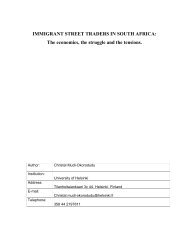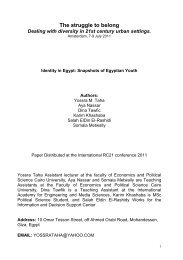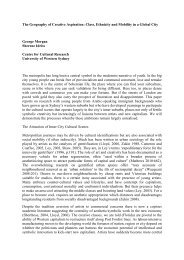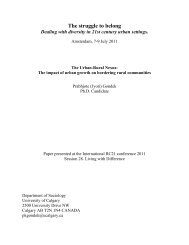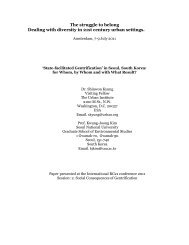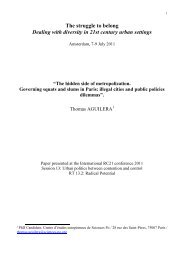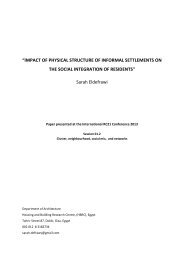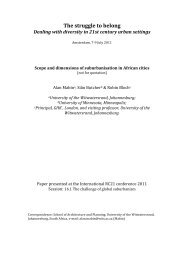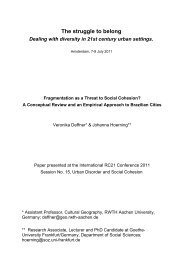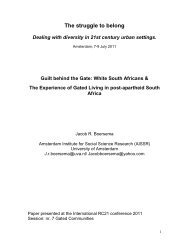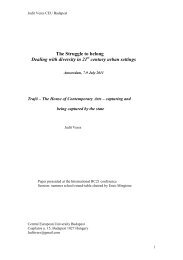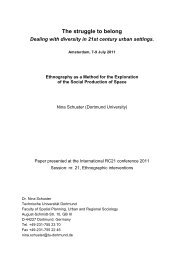Gentrification in the mill land areas of Mumbai city - RC21 ORG ...
Gentrification in the mill land areas of Mumbai city - RC21 ORG ...
Gentrification in the mill land areas of Mumbai city - RC21 ORG ...
Create successful ePaper yourself
Turn your PDF publications into a flip-book with our unique Google optimized e-Paper software.
we should understand Bombay that is as a space that conta<strong>in</strong>s several patterns and layers <strong>in</strong> its<br />
flaky structure.” The unpack<strong>in</strong>g <strong>of</strong> different layers <strong>of</strong> <strong>the</strong> area <strong>in</strong> <strong>the</strong> study <strong>of</strong> gentrification<br />
showed fragmentation <strong>of</strong> spaces and <strong>the</strong> <strong>in</strong>ternal conflicts over it. The formal and <strong>in</strong>formal<br />
practices <strong>in</strong> <strong>the</strong> area , <strong>the</strong> conflict over spaces, or <strong>the</strong> relationship among <strong>the</strong> tenants, society,<br />
builders and politicians and <strong>the</strong> <strong>in</strong>built system <strong>of</strong> negotiation constitutes and reconstitutes <strong>the</strong><br />
everyday life <strong>of</strong> <strong>the</strong> people. As Massey (1991) has always stated <strong>the</strong> sense <strong>of</strong> place doesn’t<br />
possess a s<strong>in</strong>gle identity. ‘The sense <strong>of</strong> <strong>the</strong> place is constructed’. It is redef<strong>in</strong>ed aga<strong>in</strong> and<br />
aga<strong>in</strong> as <strong>the</strong> ‘place <strong>of</strong> plurality and mix <strong>of</strong> spaces’ (Massey; Allen &Pile, 1999:52).This<br />
spaces <strong>of</strong> plurality <strong>in</strong> <strong>the</strong> process <strong>of</strong> transformation sheds its impact on <strong>the</strong> everyday life <strong>of</strong> <strong>the</strong><br />
people.<br />
Dur<strong>in</strong>g my field visit to <strong>the</strong> neighbourhood, <strong>in</strong> every busy hours <strong>of</strong> even<strong>in</strong>g or lazy Sunday<br />
morn<strong>in</strong>g or Saturday afternoon <strong>the</strong> rhythm <strong>of</strong> life changes <strong>in</strong> <strong>the</strong> neighbourhood. The waves<br />
<strong>of</strong> busy <strong>of</strong>fice goers <strong>in</strong> <strong>the</strong> morn<strong>in</strong>g go<strong>in</strong>g towards <strong>the</strong> small and big corporate <strong>of</strong>fices, <strong>in</strong><br />
different <strong>in</strong>dustrial estates and <strong>in</strong> <strong>the</strong> High Street Phoenix Mall captures <strong>the</strong> vision. Big cars<br />
like BMW struggl<strong>in</strong>g <strong>in</strong> <strong>the</strong> narrow w<strong>in</strong>d<strong>in</strong>g lane and people walk<strong>in</strong>g towards <strong>the</strong> Lower<br />
Parel Station are a usual scenario. The prom<strong>in</strong>ence <strong>of</strong> certa<strong>in</strong> groups obscures <strong>the</strong> orig<strong>in</strong>al<br />
<strong>in</strong>habitants. They become unnoticeable <strong>in</strong> <strong>the</strong> crowd. Lefevre (1991) as cited by (Massey;<br />
Allen & Pile, 1999:63) po<strong>in</strong>ted out <strong>in</strong> <strong>the</strong> “ production <strong>of</strong> social space” how certa<strong>in</strong> places and<br />
certa<strong>in</strong> groups become dom<strong>in</strong>ant over <strong>the</strong> o<strong>the</strong>rs that rhythms <strong>of</strong> certa<strong>in</strong> groups can only be<br />
heard and o<strong>the</strong>r become out <strong>of</strong> place. To <strong>the</strong>m “certa<strong>in</strong> groups superimpose <strong>the</strong>ir rhythms<br />
over <strong>the</strong> o<strong>the</strong>r (Massey; Allen & Pile, 1999:62).” Once my respondent uttered, ‘<strong>the</strong>re was a<br />
time when <strong>the</strong> entire tra<strong>in</strong> would get empty <strong>in</strong> Lower Parel and Currey Road Station and all<br />
<strong>the</strong> passengers were <strong>mill</strong> workers. Then people would walk to <strong>the</strong>ir <strong>mill</strong>s. But now all <strong>the</strong>se<br />
people work <strong>in</strong> <strong>in</strong>dustrial estate and <strong>of</strong>fices.’ When I asked <strong>the</strong> owner <strong>of</strong> <strong>the</strong> road side food<br />
stall who would sell vada pav once upon a time and now has shifted to alu paratha sabzi and<br />
lunch thali, about his customer he replied, ‘previously <strong>the</strong> <strong>mill</strong> workers used to come whereas<br />
now <strong>the</strong> people who works <strong>in</strong> <strong>the</strong> <strong>in</strong>dustrial estate, phoenix mall come for lunch and snacks.<br />
One plate <strong>of</strong> alu paratha and sabzi cost Rs 12; <strong>the</strong> o<strong>the</strong>r hotels are much more costly so people<br />
prefer to come here for lunch and snacks.’ One lazy Sunday morn<strong>in</strong>g when <strong>the</strong> local people<br />
usually move around <strong>the</strong> market place, I came near to a flower shop. The owner <strong>of</strong> <strong>the</strong> shop<br />
Satya Prakash po<strong>in</strong>ted towards <strong>the</strong> hotel by <strong>the</strong> side <strong>of</strong> his shop and remarked:



